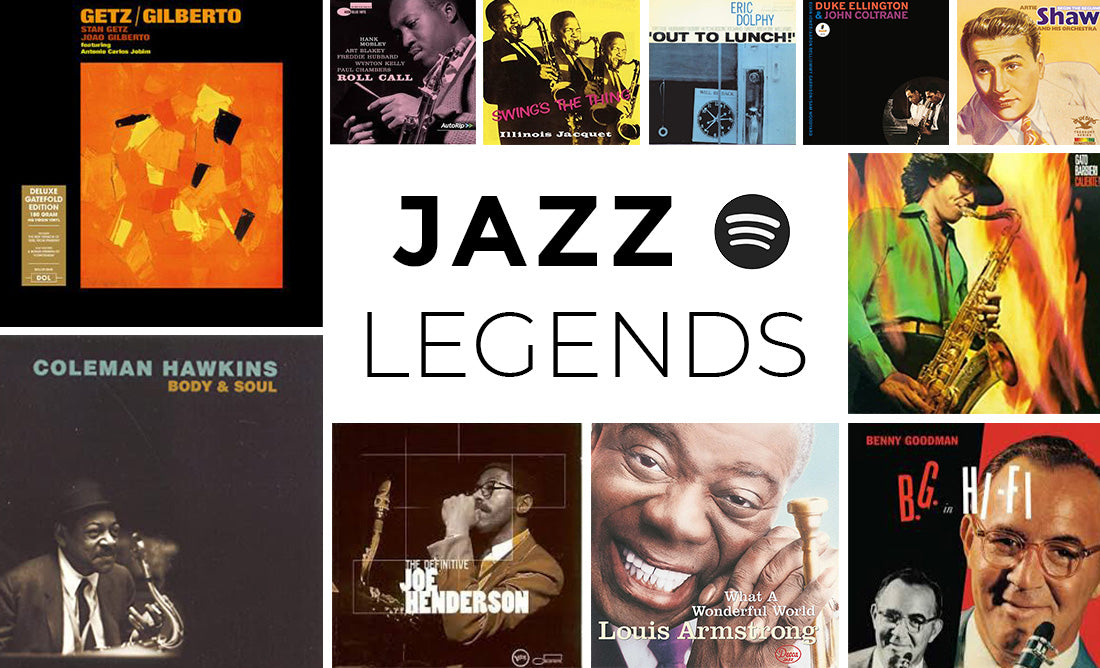The sound of jazz legends

SELMER is closely linked to the history of jazz and to the great figures who revolutionized 20th century music: Coleman Hawkins, Benny Goodman, Louis Armstrong, Django Reinhardt, John Coltrane, Stan Getz…
Discover the playlist of the jazz giants who have given us their trust and friendship.
It was in the street bands of New Orleans, and more particularly in the Storyville district, that jazz was born. At the beginning of the 20th century, when war broke out, the city became a port of war and the government closed the Storyville neighbourhood. Many musicians then migrated to other cities: Chicago, New York and Kansas City became the new cradles of jazz.
 In 1922, cornetist King Oliver founded the first major jazz band, the 'Creole Jazz Band'. New Orleans trumpeter and singer Louis Armstrong joined the band the following year.
In 1922, cornetist King Oliver founded the first major jazz band, the 'Creole Jazz Band'. New Orleans trumpeter and singer Louis Armstrong joined the band the following year.
Armstrong quickly gained international fame and established himself as one of the main jazz ambassadors around the world, taking his "little Selmer trumpet" with him everywhere (Selmer 'Balanced' Trumpet).

In the mid-1920s and up to the 1940s, the era of swing and big bands was in full bloom: Benny Goodman, "The King of Swing", was one of its main figures. He helped popularize the SELMER Centered Tone, his favourite clarinet. At the same time, Gypsy jazz became popular in France through the music of guitarist Django Reinhardt. SELMER guitars, produced between 1932 and 1952, remain inseparable from Django and are still mythical instruments highly prized by collectors today.
These years were also those of the "saxophone craze" ; Western countries experienced an unprecedented craze for the instrument. While Henri SELMER Paris became a major player in the field, several great solo saxophonists came to the forefront and influenced generations of musicians: Lester Young, Johnny Hodges, Benny Carter, Coleman Hawkins…
 In the 1940s, the be-bop revolution was built in opposition to the rigid structure of the swing. Based on a more technical and complex music, this revolutionary current also left more room for improvisation and experimentation.
In the 1940s, the be-bop revolution was built in opposition to the rigid structure of the swing. Based on a more technical and complex music, this revolutionary current also left more room for improvisation and experimentation.
The pioneers Charlie Parker, Dizzy Gillespie and Thelonious Monk were soon joined by other great figures such as Dexter Gordon or Sonny Stitt.
 At the end of the decade, cool jazz appears and stands in opposition to the frenzy and exuberance of be-bop. Among its main representatives : Miles Davis, Chet Baker, Stan Getz, Lee Konitz. Hard bop was born a few years later as a reaction to cool jazz, mostly dominated by whites. Considered as an evolution of be-bop, hard bop reintegrates elements from soul, gospel and blues. Among its main players were saxophonists Sonny Rollins, Hank Mobley and Joe Henderson. In 1954, Henri SELMER Paris revolutionized the world of the saxophone by releasing the Mark VI. Its design and ergonomics gave it iconic status and allowed it to conquer most of the great saxophonists of the time.
At the end of the decade, cool jazz appears and stands in opposition to the frenzy and exuberance of be-bop. Among its main representatives : Miles Davis, Chet Baker, Stan Getz, Lee Konitz. Hard bop was born a few years later as a reaction to cool jazz, mostly dominated by whites. Considered as an evolution of be-bop, hard bop reintegrates elements from soul, gospel and blues. Among its main players were saxophonists Sonny Rollins, Hank Mobley and Joe Henderson. In 1954, Henri SELMER Paris revolutionized the world of the saxophone by releasing the Mark VI. Its design and ergonomics gave it iconic status and allowed it to conquer most of the great saxophonists of the time.
 At the end of the 1950s, the advent of free jazz, initiated by John Coltrane and Ornette Coleman. The principle? To explode the established rules, to explore and improvise by freeing oneself from the usual structures. In the 1960s, jazz fusion (or jazz rock) was born under the influence of musicians such as Miles Davis, Herbie Hancock, Wayne Shorter and Michael Brecker. Since then, the diversity of jazz and its currents has continued to grow, integrating influences and techniques from all horizons…
At the end of the 1950s, the advent of free jazz, initiated by John Coltrane and Ornette Coleman. The principle? To explode the established rules, to explore and improvise by freeing oneself from the usual structures. In the 1960s, jazz fusion (or jazz rock) was born under the influence of musicians such as Miles Davis, Herbie Hancock, Wayne Shorter and Michael Brecker. Since then, the diversity of jazz and its currents has continued to grow, integrating influences and techniques from all horizons…
► Discover the 'Jazz Legends' playlist
► Discover the 'SELMER Sound' eclectic playlist